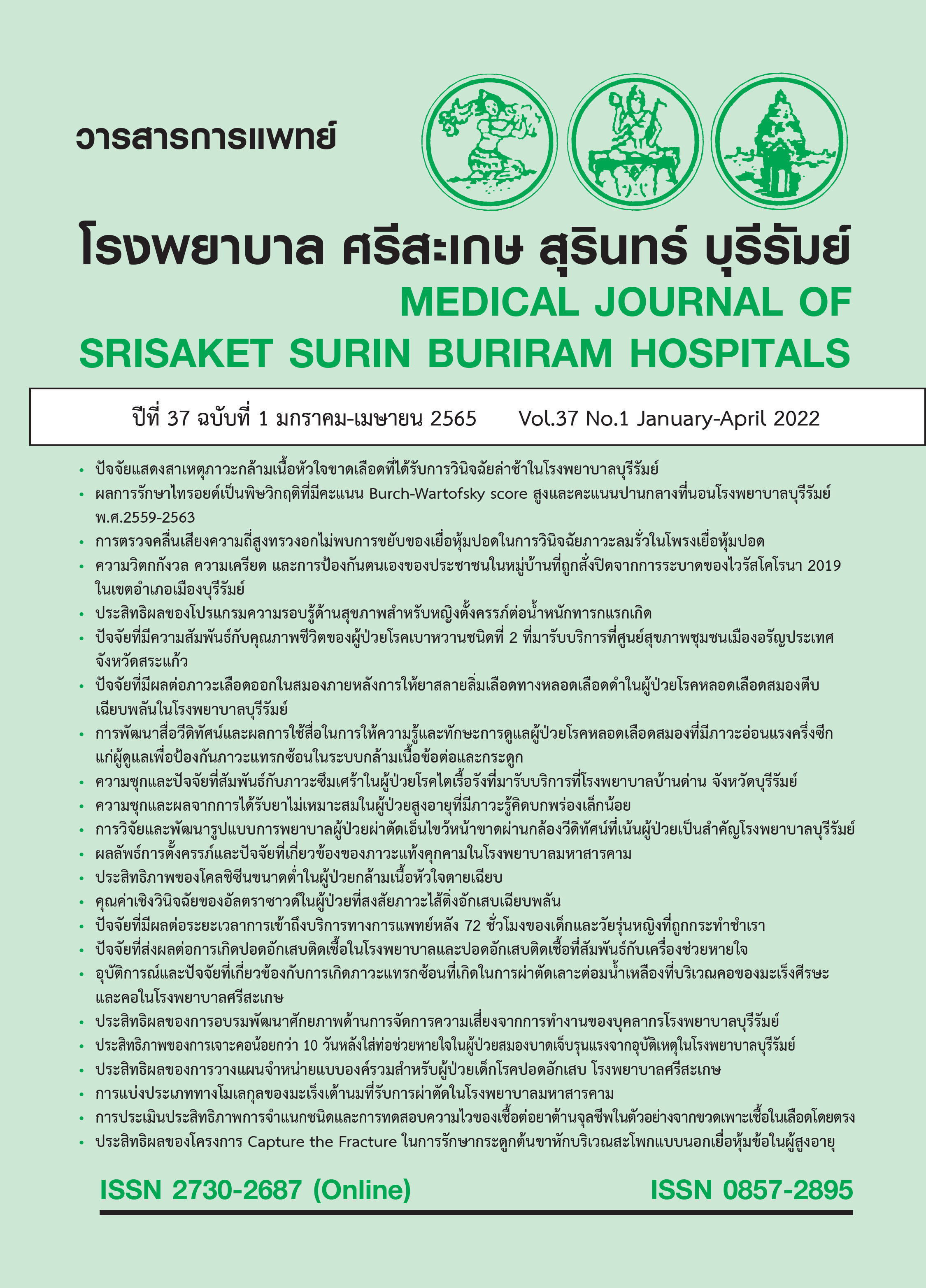Factors Associated with Hospital-acquired Pneumonia and Ventilator-associated Pneumonia
Main Article Content
Abstract
Background: Hospital-acquired pneumonia(HAP)and ventilator-associated pneumonia (VAP) were affected multiple problems such as increased length of hospital stay, multiple drug resistance, multiple antibiotics used, increased morbidity and mortality.
Objective: The aim of this study was scope the relationships between risk factors for hospital-acquired pneumonia and ventilator-associated pneumonia in internal medical intensive care patients.
Materials and methods: The study was retrospective study by collecting data in patients aged 18 and over who were admit over 48 hours in internal medical intensive care units by selecting a sample of 361 people who were admitted to the internal medical intensive care units inSisaket hospital. Data collection conducted during October 2020 -September 2021. The collecting data consisted of medical records of patients in internal medical intensive care units and Him-pro program in Sisaket hospital.
Results: The study found that the length of hospital stayed in HAP and VAP and the length of hospital stay in the group without HAP and VAP were significantly different. The incidence of hospital-associated pneumonia and ventilator-associated pneumonia was significantly higher than patients who were hospitalized greater than or equal to 8 days. The correlation study using Cox proportional hazard model demonstrated that patients with sepsis had increased risk of hospital-acquired pneumonia and ventilator-associated pneumonia. (HRAdj 1.9, 95%CI 1.1-3.4). Patients with obesity (BMI> 25 kg/m2) had increased risk of hospital-associated pneumonia and ventilator-associated pneumonia (HRAdj 1.8, 95% CI. 1.1-2.9). The use of clindamycin while admitted to the hospital will increase the risk of lung infection in hospital infections and pneumonia associated with ventilators( HR Adj1.8, 95% CI 1.2-2.7 ). The use of penicillin reduced the risk of hospital-associated sepsis and ventilator-associated pneumonia ( HR Adj 0.6, 95%CI 0.4-0.9).
Conclusion: The use of penicillin in hospitalized patient reduced the risk of hospital-associated sepsis and ventilator-associated pneumonia. The patients with underlying disease nephrotic syndrome, septicemia, BMI more than 25 kg/m2 were increased the risk of hospital-associated sepsis and ventilator-associated pneumonia.
Article Details

This work is licensed under a Creative Commons Attribution-NonCommercial-NoDerivatives 4.0 International License.
References
Kalil AC, Metersky ML, Klompas M, Muscedere J, Sweeney DA, Palmer LB, et al. Management of Adults With Hospital-acquired and Ventilator-associated Pneumonia: 2016 Clinical Practice Guidelines by the Infectious Diseases Society of America and the American Thoracic Society. Clin Infect Dis 2016;63(5):e61-e111. doi: 10.1093/cid/ciw353.
Chawla R. Epidemiology, etiology, and diagnosis of hospital-acquired pneumonia and ventilator-associated pneumonia in Asian countries. Am J Infect Control 2008;36(4 Suppl):S93-100. doi: 10.1016/j.ajic.2007.05.011.
อนุชา อภิสารธนรักษ์. โรคปอดอัเสบที่เกิดขึ้นในโรงพยาบาล. ใน: พรรณทิพย์ ฉายากูล, ชิษณุ พันธุ์เจริญ, ชุษณา สวนกระต่าย, สุรภี เทียมกริม, ยุพิน ศุพุทธมลคล, ศศิธร ลิขิตนุกูล, บรรณาธิการ. ตำราโรคติดเชื้อ 2. พิมพ์ครั้งที่ 1. กรุงเทพฯ : โฮลิสติกพับลิชชิ่ง; 2548: 1369-82.
Baker D, Quinn B. Hospital Acquired Pneumonia Prevention Initiative-2: Incidence of nonventilator hospital-acquired pneumonia in the United States Am J Infect Control 2018;46(1):2-7. doi: 10.1016/j.ajic.2017.08.036.
Werarak P, Kiratisin P, Thamlikitkul V. Hospital-acquired pneumonia and ventilator-associated pneumonia in adults at Siriraj Hospital: etiology, clinical outcomes, and impact of antimicrobial resistance. J Med Assoc Thai 2010;93 Suppl 1:S126-38.
Wałaszek M, Kosiarska A, Gniadek A, Kołpa M, Wolak Z, Dobroś W, et al. The risk factors for hospital-acquired pneumonia in the Intensive Care Unit. Przegl Epidemiol 2016;70(1):15-20, 107-10.
Fortaleza CM, Abati PA, Batista MR, Dias A. Risk factors for hospital-acquired pneumonia in nonventilated adults. Braz J Infect Dis 2009;13(4):284-8. doi: 10.1590/s1413-86702009000400009.
Hebert LA, Cosio FG, Birmingham DJ. Complement and complement regulatory proteins. In: Neilson E, Couser WG, eds. Immunologic renal diseases. Philadelphia : Lippincott Williams & Wilkins; 2001: 367.
Acedo SC, Gambero S, Cunha FG, Lorand-Metze I, Gambero A. Participation of leptin in the determination of the macrophage phenotype: an additional role in adipocyte and macrophage crosstalk. In Vitro Cell Dev Biol Anim 2013;49(6):473-8. doi: 10.1007/s11626-013-9629-x
Agrawal S, Gollapudi S, Su H, Gupta S. Leptin activates human B cells to secrete TNF-α, IL-6, and IL-10 via JAK2/STAT3 and p38MAPK/ERK1/2 signaling pathway. J Clin Immunol 2011;31(3):472-8. doi: 10.1007/s10875-010-9507-1.


